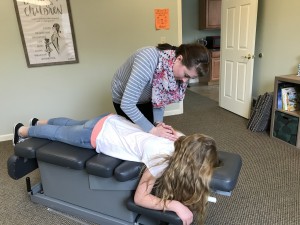Get ready for it: school is just around the corner. Parents everywhere are getting all the necessary school supplies together – pencils, notebooks, and backpacks to name a few. While these supplies can be found everywhere, have you put any thought into how these products impact your child’s health? It is not uncommon among children to experience back, shoulder, and neck pain. This could be stemming from your child’s backpack and posture.
Why is backpack safety a concern?
Have you seen how your child wears their backpack? Generally, they will wear their backpack slung over one shoulder. Also, have you weighed their backpack? Children generally carry too-much weight in their backpack, and adding in the disproportionate weight distribution of wearing the backpack on one shoulder is a recipe for disaster. Children’s bodies are developing rapidly all throughout their childhood. The offsetting weight distribution can have disastrous consequences on the developing spine.
So, what can you do?
The ACA (American Chiropractic Association) recommends limiting the backpack’s weight to 10% of the child’s body weight, as well as wearing the backpack appropriately. A heavier backpack will cause the child to lean forward to support the weight, putting added stress on the back, shoulders, and neck. If possible, talk to your child’s teachers about leaving heavier, bulkier books at school and taking home lighter hand-out materials.
Backpacks should be worn with both shoulder straps (and the waist strap if available). The straps should be padded appropriately and can be adjusted to your child. The bottom of the backpack should not be worn lower than 4 inches below the waistline. If it is too low, the weight puts too much stress on the shoulders, and your child will lean forward to compensate.
Organizing your child’s backpack will also help distribute the weight better. First, bigger is not always better. A bigger backpack leads to over packing, increasing the weight. Secondly, you want the heavier items in the backpack toward the child’s back and have pointy or oddly shaped pointed away from the body.
Lastly, try and limit the time your child is wearing the backpack. Your child’s spine will thank you.
Are all backpacks built the same?
Not all backpacks are equal. There are many different types, brands, and choices of backpacks, all with their own pros and cons. So how are you supposed to know which backpacks are best for your child? We wanted to recommend a couple different backpacks that will be best suited for your child’s health.
This product, developed by a physical therapist, changes how your child wears their backpack. Instead of the weight pulling on the shoulders and back, causing the child to lean forward, it has “saddle bags”. It has balanced side bags, distributing the weight evenly and applying the load over their center of gravity. This eliminates the forward leaning posture seen with most traditional backpacks.
The American Chiropractic Association (ACA) has recently endorsed The North Face backpacks. These traditional style backpacks come with many of the major stress-reducers, such as padded shoulder straps, sternum strap, and adjustable straps.
This is another traditional style backpack that comes with its own perks. These backpacks are made for school, day trips, or hiking, and are highly durable.
Chiropractic care

Dr. Shadley performs gentle adjustments on all of her pediatric practice members.
If your child does experience any neck, back, or shoulder pain, consider taking them to a chiropractor. Chiropractors are trained to alter and adjust their technique to be gentler on children. This can alleviate their symptoms as well as correct any structural problems that may be caused by a heavy, disproportionately loaded backpack. Call today to set up a consultation and learn how we can help your child today!
